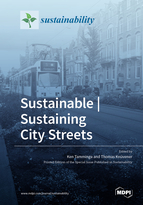Sustainable | Sustaining City Streets
A special issue of Sustainability (ISSN 2071-1050). This special issue belongs to the section "Sustainable Urban and Rural Development".
Deadline for manuscript submissions: closed (31 December 2020) | Viewed by 69722
Special Issue Editors
Interests: urban green systems and places; ecological design and restoration; community-engaged design pedagogy
Special Issues, Collections and Topics in MDPI journals
Special Issue Information
Dear Colleagues,
In 1958 urbanist Jane Jacobs wrote “there is real potential in the street.” Sixty years later, this potential remains. In this Special Issue we invite a dialogue of perspectives on the street, one that we hope will appeal to a wide range of sustainability scholars and practitioners: How do good/effective streets of all types contribute to sustaining us individually and communally in the city? Conversely, how do we promote sustainability on and near streets so that they may continue sustaining urban life?
Social and natural scientists might examine streets as socio-ecological systems, sustaining interacting life forms, human and otherwise. Interventionists—planners, designers, activists, engineers, managers—might explore morphologies, infrastructures and phenomena that sustain life along the street, and by extension the metropolis. We also call for research on those immediate contexts that exude onto, frame, and interact with the street corridor: Built form, public space, artefacts and interstices.
We hope this special issue expands the space of possible insights, technologies and best practices as they address the city street. We invite contributions from a wide range of research approaches: Empirical to experimental, conceptual to mixed-method. While we highlight the local, there is room for research at multiple scales. We especially welcome comparative and case studies.
Prof. Ken Tamminga
Dipl.-Ing. Thomas Knüvener
Guest Editor
Manuscript Submission Information
Manuscripts should be submitted online at www.mdpi.com by registering and logging in to this website. Once you are registered, click here to go to the submission form. Manuscripts can be submitted until the deadline. All submissions that pass pre-check are peer-reviewed. Accepted papers will be published continuously in the journal (as soon as accepted) and will be listed together on the special issue website. Research articles, review articles as well as short communications are invited. For planned papers, a title and short abstract (about 100 words) can be sent to the Editorial Office for announcement on this website.
Submitted manuscripts should not have been published previously, nor be under consideration for publication elsewhere (except conference proceedings papers). All manuscripts are thoroughly refereed through a single-blind peer-review process. A guide for authors and other relevant information for submission of manuscripts is available on the Instructions for Authors page. Sustainability is an international peer-reviewed open access semimonthly journal published by MDPI.
Please visit the Instructions for Authors page before submitting a manuscript. The Article Processing Charge (APC) for publication in this open access journal is 2400 CHF (Swiss Francs). Submitted papers should be well formatted and use good English. Authors may use MDPI's English editing service prior to publication or during author revisions.
Keywords
- street as place
- street as ecology
- multi-function streets
- green transitways
- open streets
- convivial greenstreets
- walkable streets
- complete versus incomplete streets
- active streets
- street mobility
- transition streets
- low-carbon streets
- smart streets







